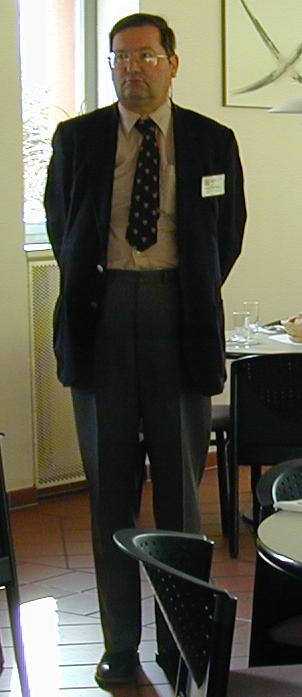A computer algebra system (CAS) or symbolic algebra system (SAS) is any mathematical software with the ability to manipulate mathematical expressions in a way similar to the traditional manual computations of mathematicians and scientists. The development of the computer algebra systems in the second half of the 20th century is part of the discipline of "computer algebra" or "symbolic computation", which has spurred work in algorithms over mathematical objects such as polynomials.
In symbolic computation, the Risch algorithm is a method of indefinite integration used in some computer algebra systems to find antiderivatives. It is named after the American mathematician Robert Henry Risch, a specialist in computer algebra who developed it in 1968.

Theoretical computer science (TCS) is a subset of general computer science and mathematics that focuses on mathematical aspects of computer science such as the theory of computation, formal language theory, the lambda calculus and type theory.
Axiom is a free, general-purpose computer algebra system. It consists of an interpreter environment, a compiler and a library, which defines a strongly typed hierarchy.

Yacas is a general-purpose computer algebra system. The name is an acronym for Yet Another Computer Algebra System.
Computational science, also known as scientific computing, technical computing or scientific computation (SC), is a division of science that uses advanced computing capabilities to understand and solve complex physical problems. This includes

Bruno Buchberger is Professor of Computer Mathematics at Johannes Kepler University in Linz, Austria. In his 1965 Ph.D. thesis, he created the theory of Gröbner bases, and has developed this theory throughout his career. He named these objects after his advisor Wolfgang Gröbner. Since 1995, he has been active in the Theorema project at the University of Linz.
Symbolic Manipulation Program, usually called SMP, was a computer algebra system designed by Chris A. Cole and Stephen Wolfram at Caltech circa 1979. It was initially developed in the Caltech physics department with contributions from Geoffrey C. Fox, Jeffrey M. Greif, Eric D. Mjolsness, Larry J. Romans, Timothy Shaw, and Anthony E. Terrano.

Computational mathematics is an area of mathematics devoted to the interaction between mathematics and computer computation.

James Harold Davenport is a British computer scientist who works in computer algebra. Having done his PhD and early research at the Computer Laboratory, University of Cambridge, he is the Hebron and Medlock Professor of Information Technology at the University of Bath in Bath, England.

In mathematics and computer science, computer algebra, also called symbolic computation or algebraic computation, is a scientific area that refers to the study and development of algorithms and software for manipulating mathematical expressions and other mathematical objects. Although computer algebra could be considered a subfield of scientific computing, they are generally considered as distinct fields because scientific computing is usually based on numerical computation with approximate floating point numbers, while symbolic computation emphasizes exact computation with expressions containing variables that have no given value and are manipulated as symbols.
The International Journal of Algebra and Computation is published by World Scientific, and contains articles on general mathematics, as well as:
Joachim von zur Gathen is a German computer scientist. His research spans several areas in mathematics and computer science, including computational complexity, cryptography, finite fields, and computer algebra.
Daniel Lazard is a French mathematician and computer scientist. He is emeritus professor at Pierre and Marie Curie University.
ISSAC, the International Symposium on Symbolic and Algebraic Computation, is an academic conference in the field of computer algebra. ISSAC has been organized annually since 1988, typically in July. The conference is regularly sponsored by the Association for Computing Machinery special interest group SIGSAM, and the proceedings since 1989 have been published by ACM. ISSAC is considered as being one of the most influential conferences for the publication of scientific computing research.
Vladimir P. Gerdt was a Russian mathematician and a full professor at the Joint Institute for Nuclear Research (JINR) where he was the head of the Group of Algebraic and Quantum Computations. His research interests were concentrated in computer algebra, symbolic and algebraic computations, algebraic and numerical analysis of nonlinear differential equations, polynomial equations, applications to mathematics and physics, and quantum computation with over 210 published articles.
FGLM is one of the main algorithms in computer algebra, named after its designers, Faugère, Gianni, Lazard and Mora. They introduced their algorithm in 1993. The input of the algorithm is a Gröbner basis of a zero-dimensional ideal in the ring of polynomials over a field with respect to a monomial order and a second monomial order. As its output, it returns a Gröbner basis of the ideal with respect to the second ordering. The algorithm is a fundamental tool in computer algebra and has been implemented in most of the computer algebra systems. The complexity of FGLM is O(nD3), where n is the number of variables of the polynomials and D is the degree of the ideal. There are several generalization and various applications for FGLM.
In mathematics, a sparse polynomial is a polynomial that has far fewer terms than its degree and number of variables would suggest. For example, x10 + 3x3 - 1 is a sparse polynomial as it is a trinomial with a degree of 10.
Deepak Kapur is a Distinguished Professor in the Department of Computer Science at the University of New Mexico.






